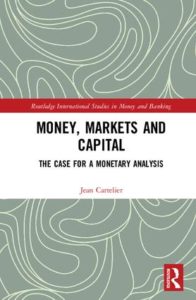Money, Markets and Capital
The Case for a Monetary Analysis
By Jean Cartelier
Routledge
240 pages | 21 B/W Illus.
Book’s page on the Publisher’s website
Money and payments are familiar to everybody. Economists however are often at a loss in assessing the extent to which money matters. As a matter of fact, money is at the origin of the main cleavage in economic theory. Beyond sophisticated models what is at stake is whether money is just an appearance which hides the essence of economic life (value and happiness of people) or, on the contrary, the very substance of economic relations, not limited to exchanges, in which power and sovereignty are ever present.
In a first part, the author shows how fragile and shaky are the attempts made by value theoreticians to integrate money into their analysis. In a second part, he develops a rigorous alternative theory by giving strong logical foundations to a monetary analysis in the spirit of Keynes. Many important economic phenomena left unexplained by academic theory are accounted for (involuntary equilibrium unemployment), a new method in dynamics is resorted to (viability theory) and various economic relations are elucidated which are not reducible to exchange, the only one dealt with by academic theoreticians. This is the case of the wage relationship.
Although written in view of an audience acquainted with economic theory, this book can be read nevertheless by a larger circle since the technicalities have been reduced to what is strictly necessary to understand what is at stake.
List of Tables;
List of Schemas;
Introduction;
Chapter 1: A bird-eye’s view;
Chapter 2: Integration of money into value theory and neutrality in a nutshell; The problem of integration; Neutrality of money: the Grail of money theory?;
Chapter 3: Money: fiat money or social device for coordination?; The essence of money; The incentives for going beyond academic theory;
Part II. The case for a monetary analysis;
Chapter 4: Primitives of a monetary analysis; The fundamental postulates; Money and accounts: a close connexion; The minting process, a crucial element of a monetary economy;
Chapter 5: A pure market economy: exchange relations; A market economy: main characteristics; Some propositions; The dynamics of market relations;
Chapter 6: Entrepreneurs, wage-earners and capitalists; The rationale for the differentiation of entrepreneurs and wage-earners; Specific properties of an entrepreneur economy; The level of activity: a crucial point; Appendix;
Chapter 7: Some specific properties of a capitalist economy; Kalecki principle; Involuntary unemployment steady-states: Solow as a special case of a monetary analysis; Disequilibrium dynamics: Harrod’s razor-edge; From entrepreneur economy to finance; Appendix;
Conclusion; Some advances of the present essay; Legal money; Out-of-equilibrium situations; Involuntary unemployment equilibria and foundations for Keynes economics; Economics and the plurality of social disciplines: a suggested interpretation; Money mediation as a self-referential system amongst others; Self-referential systems and complexity;
References;
